WORLD CLASS COACHING
Pro Possession Games
By Renato Lopes Moreira
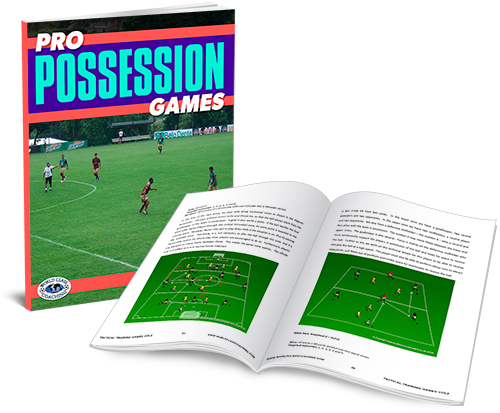
Table of Contents
PART ONE
Introduction
Warm-Ups
Small Group Situations
PART TWO
Four-Player Situations
PART THREE
Five-Player Situations
PART FOUR
Six-Player Situations
Large Group Situations
Introduction
"If you keep possession of the ball, the opponent does not have it."
It was with this phrase that the legendary Johann Cruyff (1947 - 2016) defined why his teams always seek control of matches. Guardiola, one of the greatest followers of Cruyff's game philosophy, in an interview given in 2017, reinforced the importance of possession football with the following phrase:
"If that happens (ball possession soccer will stop working), I will retire from football, because I do not see any other way to do that."
These two coaches share a game philosophy centered on the idea of having possession of the ball. So we have the question: Is ball possession really important in soccer? If so, why in the last edition of the World Cup, did the teams with the highest averages of ball possession end up being eliminated early?
But, let's think: to attack, you need to have the ball. Right?
Regardless of whether you have 70% ball possession or you have a ball briefly on the counterattack, you need to have the ball with you. So, ball possession is something vital in soccer. But, returning to the question of having the ball possession or not, the idea of this material is not to defend one side in this discussion, but to present the importance of possession of ball in soccer. How you will use this information will be up to you.
To start, let's recall the Operational Principles of Collective Sports (OPCS), defined by the Frenchman Claude Bayer in his book "Theory of Collective Sports,” released in 1994.
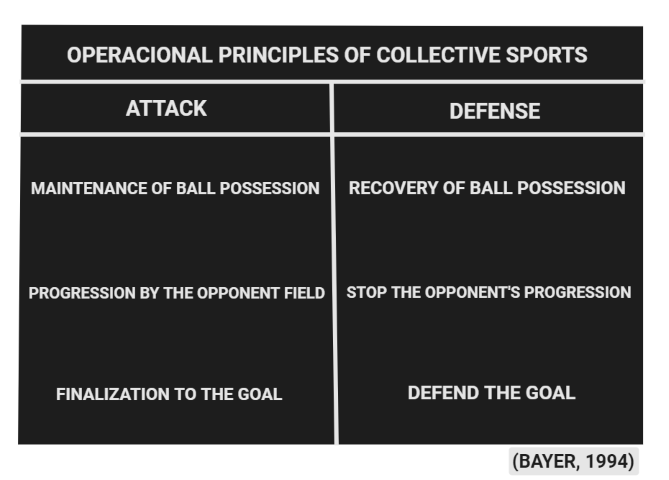
Now let's take a look at these principles, but especially the offensive ones:
Maintenance of ball possession: The attack will coordinate your actions to conserve the ball so as to wait for the right moment to attack, after unbalancing the opponent's defense and opting for the best way to end the attack. It is a fact that the goal in soccer does not happen by chance, so keep the ball possession is something so important.
Keeping the ball possession you force your opponent to play in order to always recover it.
You keeping the ball possession, we enter the second principle of attack, which is to:
Progression by the opponent field: Soccer is an invasion game, and the target I want to attack is in my opponent's field. Therefore, I need to advance to my opponent's field to increase my offensive chances. The closer I get to my opponent's goal, the higher my chances of scoring a goal.
We keep possession, we advance through the opposing field and now we enter Bayer's third principle:
Attacking the goal: The main goal of soccer is to score goals. If I score more goals than my opponent I win the game. In order to score the goal, I need to be very close to the goal of my opponent and with the ball possession. That is, if the two other principles are not well executed, I will not be able to score and this will reduce my chances of winning the match.
With all the operational principles of play understood, especially those of attack, we can return to the discussion about ball possession.
You do not have to have 70% possession of the ball every game to win the matches. Claudio Ranieri won a Premier League recently with Leicester with much less ball possession than his opponents. Mourinho won several national leagues and two Champions just playing with less ball possession. So why do I want to have more ball possession if, with a more vertical, direct and simple game, I can win matches and titles? Building the game requires a lot of ball possession on my players' feet, which increases the chance of my team making a mistake. Right?
Wrong.
Okay, building the game and maintaining ball possession for a long time during the matches is hard. Just as hard as you playing for only one ball.
Soccer can be a simple game, but it's not yet that simple to define one thing like this.
My idea here is to forget about your percentage of ball possession.
Focus on her effectiveness. Focus on the collective organization she gives you, when having 70% ball possession or playing for just one ball. Soccer wins come from who scores more goals.
The more effective my ball possession is, better for my team. This is a fact. Barcelona's ball possession game has its virtues, as does Leicester's one ball possession game. They work because they are effective in their proposals. If ball possession were the only important numbers, Germany and Spain would have made the final of the Russian World Cup instead of leaving the competition early as they did.
The purpose of this material is to help you with ball possession, presenting some exercises with the main focus on this question. All games are general, adaptable to any change or variation you may think of or want to adapt to your team. Just remember that any change directly influences the dynamics of the exercises and you have to keep this in mind. Your game model should prevail over any exercise thought or applied.
The main focus of this material is to present exercises about ball possession. There are 24 exercises that you can easily transform into many more, just thinking about other variables or exercises. In these exercises you will see that the most important is the game space, just as the importance of a conscious and balanced occupation that will help the maintenance of the ball possession and the advance through the opponent’s field.
In the defensive aspect, the main focus is the pressing, the desire to recover the ball as soon as we can to be able to counterattack.
As the games are in reduced space, the physical component will always be very demanding, helping your team's conditioning. But, the intensity and duration of each exercise is up to you to define, according to the characteristics of your team.
To conclude, always remember: ball possession is not the numbers that appear as statistics during the matches or are commented daily on television. Numbers are cold and sometimes do not describe the reality of the game. Your team has to be effective in his game idea.
Always be effective in your proposal and, when you have the ball possession in your favor, always use it to organize your team, execute your attack ideas and score many goals as you can.
CHAPTER 1 – Warmup game situation
1x1 + 1 - Chaotic game - possession game
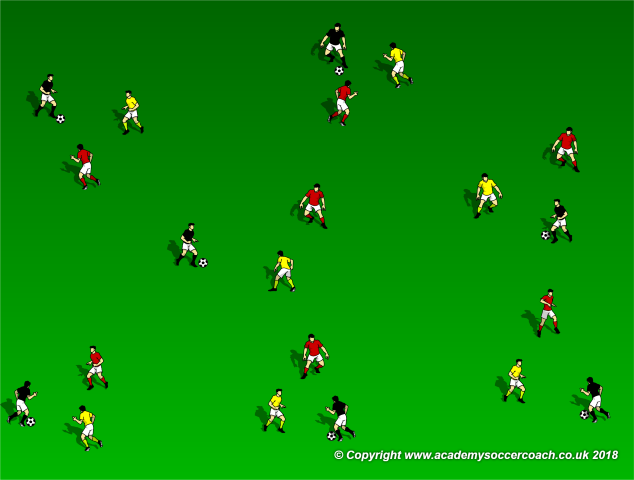
Setup:
21 players
50x30 meters game field
Execution:
Divide the team in trios.
Any attacker can play with any Joker during the exercise;
It is allowed one defender per attacker;
If the defender gets the ball possession, he starts to play along any Joker
Variations:
. You can increase or decrease the number of players involved;
. You can vary the number of defenders for each attacker;
. You can limit the number of touches on the ball by each player.
1x1 + 1 possession game
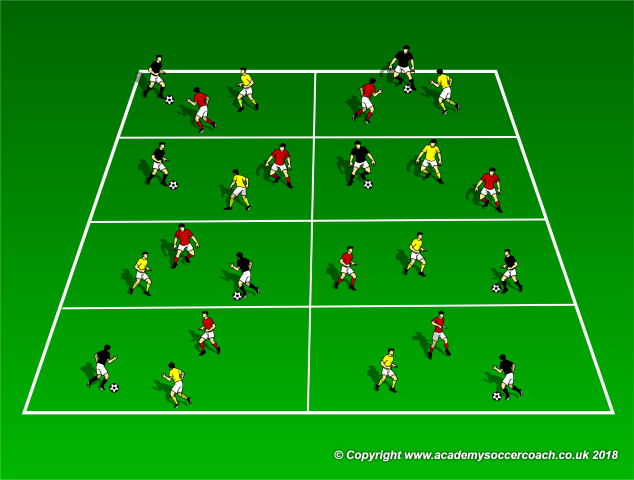
Setup:
21 players
50x35 meters game field
Execution:
Divide the team in trios and divide the field into small fields;
Put one trio inside one small field;
The attacker will play with the Joker during the exercise;
If the defender gets the ball possession, he starts to play along with the Joker
Variations:
. You can increase or decrease the number of players involved;
. You can vary the number of defenders for each attacker;
. You can limit the number of touches on the ball by each player.
2x2 + 2 Jokers possession game
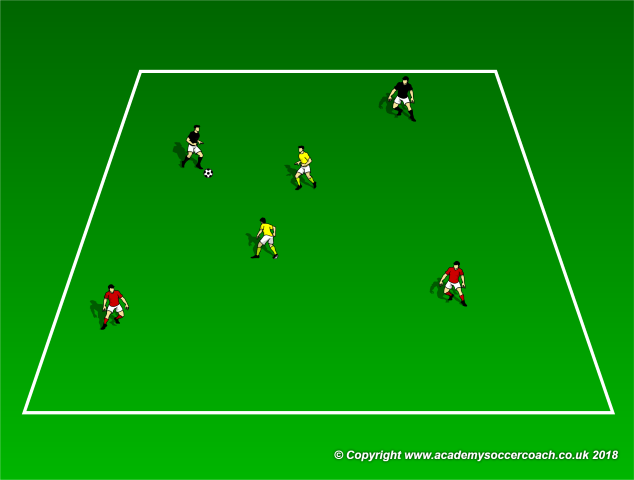
Setup:
6 players
10x10 meters game field
Execution:
The attack can play with the Jokers while have the ball possession;
Five consecutive passes is a point for the attack;
If the defense recovers the ball possession, they automatically start to pass the ball.
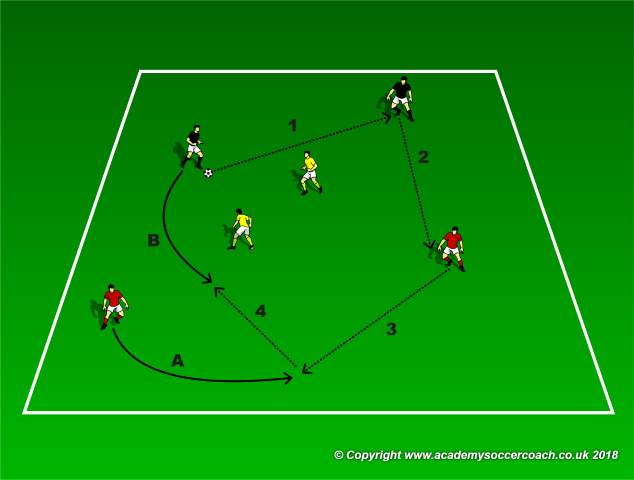
Variations:
. You can increase or decrease the number of players involved;
. You can increase or decrease the number of Jokers;
. You can increase or decrease the game field area;
. You can define several touches on the ball by each player;
. You can vary the number of consecutive passes to score a point;
. You can put other small fields near and start a competition.
3x3 + 4 possession game
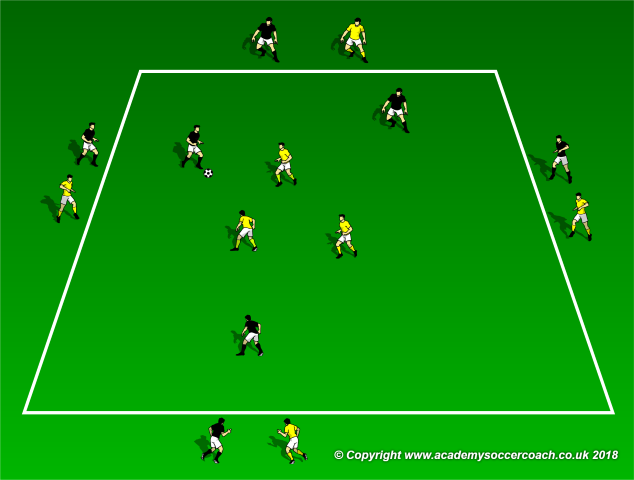
Setup:
14 players
20x20 meters game field
Execution:
Divide the players in two teams;
Three players of each team will stay inside the game field while the others will stay outside;
The attackers will try to do the most passes between then, trying to maintain the ball possession as long as they can;
While the attack is moving the ball only the three defenders can try to get the ball possession. The outside defenders remain statics in their positions;
It's not allowed to outside attackers move the ball between them. The ball must pass inside the game field to move around;
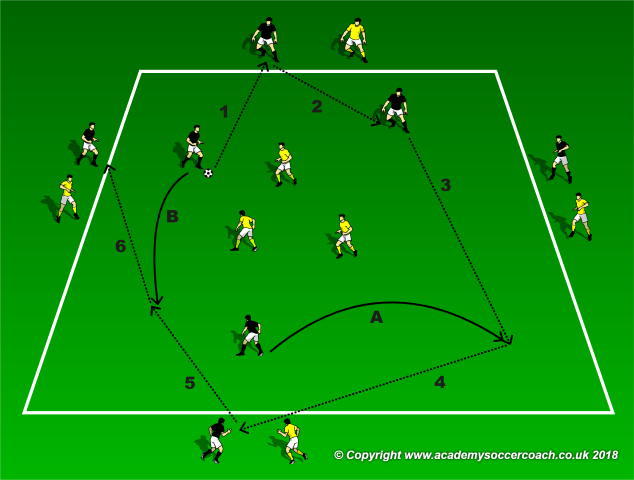
Every five consecutive pass, the attack scores one point;
If the defense recovers the ball possession, they automatically start to move the ball and count their passes.
Variations:
. You can increase or decrease the number of players involved;
. You can define several touches on the ball by each player;
. You can allow the outside defenders to try to steal the ball possession.
4x2 - pair game - possession game
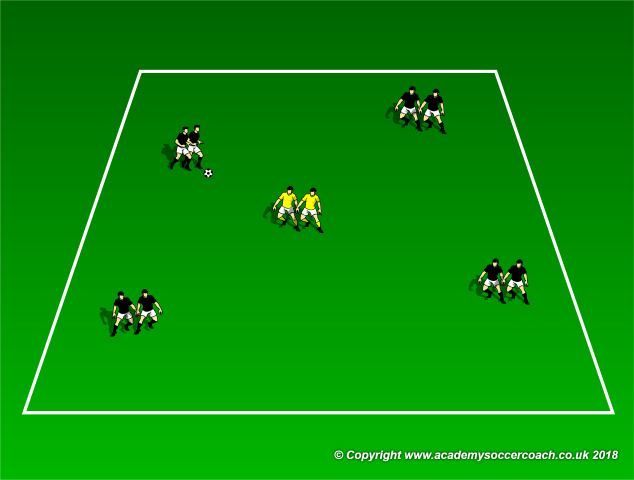
Setup:
10 players
18x10 meters game field
Execution:
The players will form pairs;
The pairs can't release their hands during the whole exercise;
The pairs are not allowed to make a one touch pass between them;
One player of the pair receives the ball, make a short pass to his teammate and he made a medium or long pass for another pair;
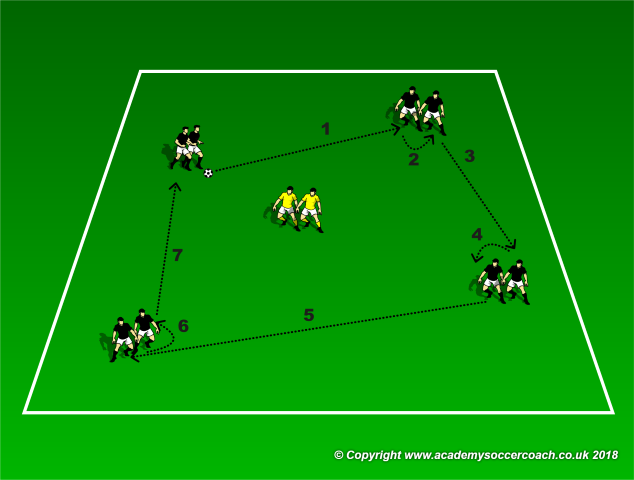
If the defense gets the ball possession, the pair switches position with the attackers who lost the ball.
Variations:
. You can increase or decrease the number of players involved;
. You can allow free touches on the ball for each pair;
. You can use triplets, quartets or any formation you want.
12x3 - 1 touch - possession game
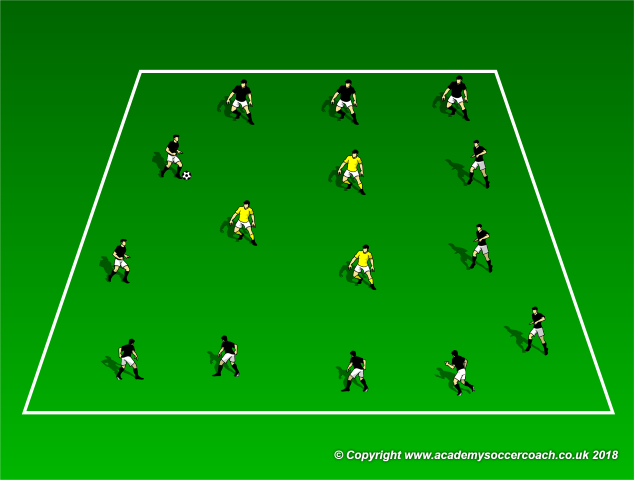
Setup:
15 players
20x10 meters game field.
Execution:
The attack must touch the ball between them without losing the ball possession;
Each player is allowed one touch;
The defender who gets the ball possession switches position with the attacker who loses the ball;
If one attacker passes the ball directly outside the game field, he and two other players chosen by him will switch function with the defenders.
Variations:
. You can increase the number of players involved;
. You can vary the type of pass by each player.


